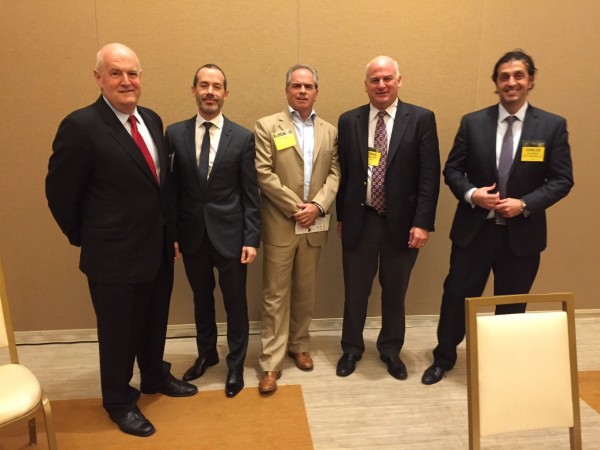
By Mariana Jackson
The 2015 HOLA (Hotel Opportunities Latin America) Conference took place April 28-30 at the J.W. Marriott Marquis Hotel in Miami. The conference projected a focus on occupancy in Central America since supply has been outpacing demand since mid-2012. An emphasis on this current strategy to attract demand is critical to support further hospitality development in Central America. Plenary sessions, however exuded enthusiasm and optimism. Here is just a handful of the critical “takeaways” from last week’s HOLA event:
1) What is the Outlook for Destination Cuba – The Undiscovered Country?
Not surprisingly, panelists were convinced that tourism is the golden ticket to Cuba’s future development. Optimism filled the room during the premier session which focused on the long-awaited opening of the Cuban market. The natural, authentic and untouched beauty of the country complemented by the convenient access from the United States make Cuba a very attractive destination to hotel and resort developers. Panelists are hopeful that once the United States drops the embargo and opens its market, tourism will be further explored and the need for quality hotel products will be more significant.
Other Latin American destinations, such as Jamaica and Mexico, demonstrated some concern that the possibility of Cuba opening its market to tourism may impact their own visitor levels. However, it is generally believed that Cuba will not, in fact, create a threat to other destinations but rather it will induce new demand to the region.
Despite the challenges regarding Cuba’s developmental and tourism infrastructure, internal policies, and even quality of products, developers’ interest to explore the country could not be stronger. It is believed that cruise lines will initially benefit from the relaxing of Cuba’s tourism policies due to the comfort and sense of security provided by the day-in-port scheduling. However, the hotel industry will eventually benefit once the destination becomes more popular.
Spanish brands are already successfully operating hotels in Cuba. With tourism expansion, American brands are anxious to enter the market and develop products that will appeal to the nuances and needs of the American traveler. As we see with American visitation to the Bahamas, which also benefits from ease of access, the proximity to the island could potentially also result in Cuba evolving into a weekend destination.
2) Where are the Opportunities in Central America?
Central America still has many areas that have not yet been explored. With that in mind, panelists and brand representatives were enthusiastic about the opportunities of this continued emerging market. However, with the current pipeline, both Costa Rica and Panama are the clear leaders in terms of supply and will exceed 20,000 hotel rooms in the short-term.
HOLA panelists, when referencing Central America, considered statistics from Panama, Nicaragua, Honduras, Costa Rica, El Salvador and Guatemala. Combined rooms inventory of all these countries totals 165,086 with 13% consisting of 4 or 5 stars hotel properties.
Panama has the majority of its developments concentrated in the city and surrounding the Panama Canal. Occupancy and ADR levels dropped by approximately 5% from 2013 to 2014 due to an oversupply of hotels. However, anticipation now exists for the supply to be absorbed as the destination awaits the opening of their Convention Center slated for an opening during the 4th quarter of 2015. Panelists were also optimistic about the market quickly absorbing the supply as Panama has strongly invested in infrastructure, possesses strong leadership, respect and advocacy for tourism.
Although at a slower pace, Honduras and Nicaragua also demonstrated signs of development and raised developers’ eyebrows. Politically, Nicaragua has been stable and is eager to establish relationships with investors. It also has the lowest cost of living in Central America. In 2014, Nicaragua had the strongest ADR growth in Central America.
Brand leaders emphasized that most of the opportunities in Central America revolve around the opening of select- or limited-service hotels, due to a better profile fit (in non-resort markets, primary) and return on investment requirements. The major brands also voiced interest in continuing to develop all-inclusive projects in the region.
Numerous hoteliers, working independently or in conjunction with brands, are actively developing throughout Mexico. The political concerns do not intimidate investors as tourism investment remains strong and capital markets continue to grow. RevPAR in 2014 increased 8% compared to the previous year. Also notable for Mexico, is a healthy pipeline of an additional 20,000 hotel rooms.
Overall, the construction pipeline is in Central American is extremely robust and healthy. However, in our opinion, the strong spike in supply growth must be tempered by a strategic plan that will focus on occupancy.
3) Is there a Future for Lifestyle Brands in Latin America?
- “…the way a traveler wants to experience the hotel and be connected to the local community”
- “…created to target a sector of the market with a specific lifestyle”
- “catered to specific likes and dislikes”
- “hip and trendy”
While many industry professionals attempted to define “lifestyle brand,” no two executives could come to a singular definition. However, it was agreed that “lifestyle” is a brand-driven concept whose success is driven on proper psychographic analysis.
According to Todd Wynne-Perry of Commune Hotels and Resorts, lifestyle brands are moved by five drivers under the umbrella of “authenticity”:
- Local relevance
- Guest connectivity with the hotel
- Excellent technology
- Quality food and beverage with emphasis on local flavors
- Communal or social areas
The advantages of developing lifestyle brands in Latin America are related to the flexibility of the brand, opportunity to explore the local flavors and the opportunity to “wow” guests with an innovative product not yet present in the area.
The hot spots for development of lifestyle product are the major primary markets of South America such as Bogota, Mexico City, Lima and Santiago.
For developers interested in entering the Latin American market, it is important to consider that “new builds” may be more beneficial than conversions due to brand requirements, as well as the design flexibility that is required to implement a lifestyle brand.
Denis Ebrill of Melia Hotels International stated that owners and investors are not interested in these types of brands because they are hip and cool, but rather their interest originates from the possibility of obtaining higher returns by delivering a product that matches consumer needs. In Latin America, well recognized lifestyle brands have reported higher levels of ADR.
Unlike “cookie cutter” brands, lifestyle brands must be dynamic and trendy. The challenge with this segment is to understand that what is relevant today may not necessarily be relevant tomorrow. Hence, the brands have to prepare to reinvent themselves more frequently and higher reserve for replacement may be necessary. Refreshing soft goods or keeping up with product maintenance may not be sufficient to continually appeal to a new and dynamic generation.

HVS Miami Shares Insights, Observations and Next Steps:
There are many areas and opportunities to be explored in Latin America. However, the recent trend on supply in Central America outpacing demand is a concern and should not be overlooked. Located in the gateway to Latin America, HVS Miami urges for developers to find a professional and networked local partner, and to seek the advice of a strategic hospitality advisor that can provide proper advisory and foresight, such as HVS Consulting & Valuation. This will enable investors to obtain a profound understanding of the market and, allow partners to help pave a path to success.

